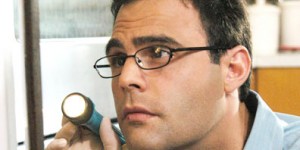I don’t know Kevin McDonald but I’ve laughed with him for 20 years as one of the founders of the popular Canadian comedy troupe, Kids in the Hall.
I also regularly insert his videos into barfblog.com, and say catchlines to Amy like, How the Hell Could I Know, or I Can’t Help Blaming Myself, but I Also Can’t Help Not Caring,  Slipped My Mind, and There’s Nothing Like Clean Sheets (and a rock hard alibi).
Slipped My Mind, and There’s Nothing Like Clean Sheets (and a rock hard alibi).
So who knew I’d have a grad student that knew Kevin.
But this is really about that graduate student, Rob Mancini, who got his research published.
It’s not a TV show, but for science nerds, it’s the credibility that counts.
New methods of food safety training need to be developed and health inspections do help correct unsafe food preparation practices, according to new research from Kansas State University.
Rob Mancini, a MS graduate of Kansas State and a health inspector with the Manitoba Department of Health, led a study of how to improve food safety at Folklorama in Winnipeg, Manitoba, Canada, a 14-day temporary food service event that explores the many different cultural realms of food, food preparation, and entertainment.
The results were published in the Oct. issue of the Journal of Food Protection.
In 2010, the Russian pavilion at Folklorama was implicated in a foodborne outbreak of Escherichia coli O157 that caused 37 illnesses and 18 hospitalizations. The ethnic nature and diversity of foods prepared within each pavilion presents a unique problem for food inspectors, as each culture prepares food in their own unique way.
The Manitoba Department of Health and Folklorama Board of Directors realized a need to implement a food safety information delivery program that would be more effective than a 2-h food safety course delivered via PowerPoint slides. The food operators and event coordinators of five randomly chosen pavilions selling potentially hazardous food were trained on-site, in their work environment, focusing on critical control points specific to their  menu. A control group (five pavilions) did not receive on-site food safety training and were assessed concurrently. Public health inspections for all 10 pavilions were performed by Certified Public Health Inspectors employed with Manitoba Health. Critical infractions were assessed by means of standardized food protection inspection reports.
menu. A control group (five pavilions) did not receive on-site food safety training and were assessed concurrently. Public health inspections for all 10 pavilions were performed by Certified Public Health Inspectors employed with Manitoba Health. Critical infractions were assessed by means of standardized food protection inspection reports.
The results suggested no statistically significant difference in food inspection scores between the trained and control groups. However, it was found that inspection report results increased for both the control and trained groups from the first inspection to the second, implying that public health inspections are necessary in correcting unsafe food safety practices. The results further show that in this case, the 2 hour food safety course delivered via slides was sufficient to pass public health inspections. Further evaluations of alternative food safety training approaches are warranted.
“Rob was an outstanding graduate student and his research highlights the value of reality research,” said supervisor Dr. Douglas Powell, a professor of food safety in the Department of Diagnostic Medicine/Pathobiology at Kansas State University. “The research was done in the field, Rob took all his courses by distance, but we communicated regularly using electronic tools.
Other authors include Dr. Leigh Murray of the Dept. of Statistics at Kansas State, and Dr. Ben Chapman, an assistant professor at North Carolina State University.
A video highlighting the results of the research featuring Mancini and Kevin McDonald is available at http://www.youtube.com/watch?v=wLlrv-3266o&feature=youtu.be.
Investigating the potential benefits of on-site food safety training for Folklorama, a temporary food service event
01.oct.12
Journal of Food Protection®, Volume 75, Number 10, October 2012 , pp. 1829-1834(6)
Mancini, Roberto; Murray, Leigh; Chapman, Benjamin J.; Powell, Douglas A.
http://www.ingentaconnect.com/content/iafp/jfp/2012/00000075/00000010/art00014

 What better occasion to try out alleged
What better occasion to try out alleged  And I didn’t take pictures of Thursday’s dinner, but Top Chef on Wed. night also struggled with lamb, and none of the hot-shot chefs could agree on how to define medium-rare lamb.
And I didn’t take pictures of Thursday’s dinner, but Top Chef on Wed. night also struggled with lamb, and none of the hot-shot chefs could agree on how to define medium-rare lamb.  The lamb shoulder roast we had last night was cooked to 140F.
The lamb shoulder roast we had last night was cooked to 140F. .jpg) “When you look at Kellogg, we have 3,000 ingredients and 1,000 suppliers, I think it’s common industry practice to use a third party.”
“When you look at Kellogg, we have 3,000 ingredients and 1,000 suppliers, I think it’s common industry practice to use a third party.”